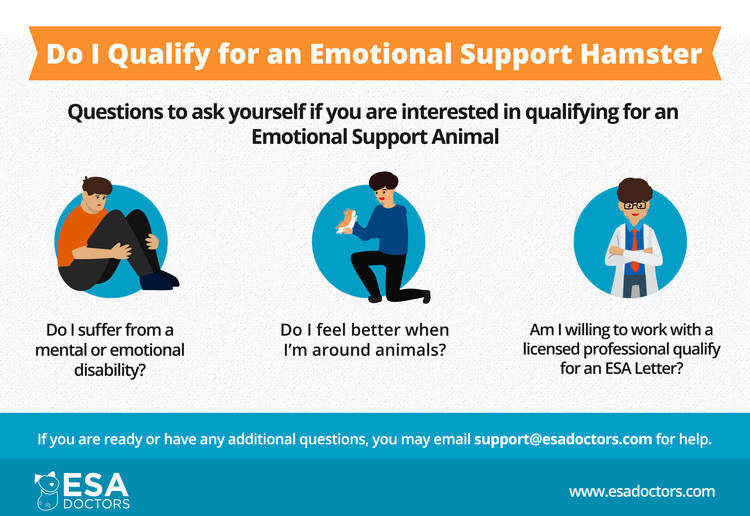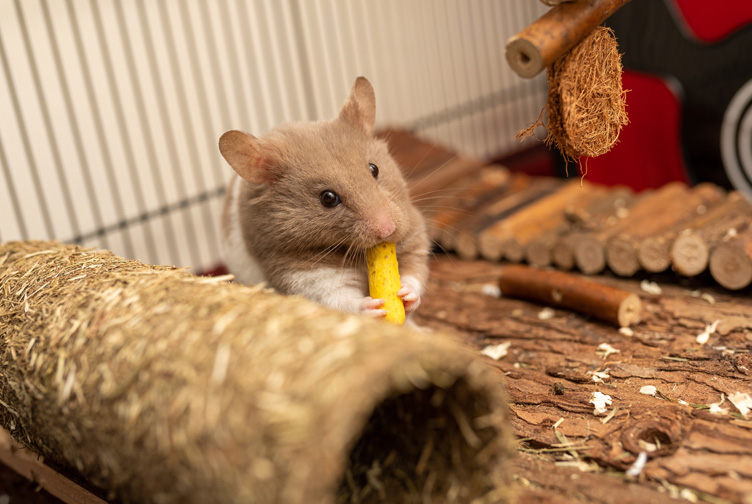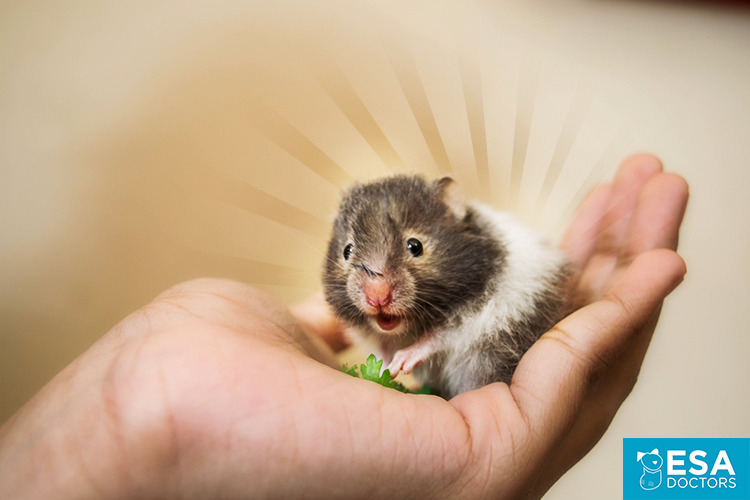An emotional support animal (ESA) is much more than a pet. An ESA fulfills a specific role as a therapeutic source to someone with an emotional or mental disability. By providing company, affection, and attention, an emotional support animal can make the difference for someone trying to overcome a diagnosed disability.
Unlike a service animal, an emotional support animal is not individually trained to perform specific tasks for people with disabilities. Their therapeutic presence in the lives of someone with an emotional or mental disability can significantly improve their quality of life and reduce their symptoms. Therefore, any domesticated pet can become an ESA—including hamsters.

Emotional Support Animal Options
Any animal that is domesticated and not disruptive in private locations or public areas can serve as an emotional support animal. The most common ESAs are:
Other examples of ESA’s are bearded dragons, mini-pigs, and mice. There are a few logistical issues to respect. An elephant, for instance, maybe domesticated but would be a disruption in public because of its size!
Size and convenience are things to consider when deciding on an emotional support animal.
ESA Doctors, est. 2015
Although often overlooked but function wonderfully as an emotional support animal are hamsters.

ESA Hamsters: Adorable, Portable, and Convenient
The thought of hamsters as an ESA may seem unconventional, but hamsters have long been loved as pets by both children and adults. As small as they are, hamsters have personalities and have been known to display signs of attachment. Besides, they look just plain adorable!
1. Hamsters are Reasonably Easy to Care For
Very often, the work and cost of maintaining a dog or a cat can deter someone who would benefit from an ESA from obtaining one. With a hamster however the costs of care are minimal. Hamsters do not require large amounts of food, water, and only need relatively small living space. They groom themselves and eliminate tiny, easy to clean pellets as waste. Hamsters may also have lower veterinary fees and overall require fewer resources.
2. Hamsters Make Great Travel Companions
Hamsters are also very easy to travel with. Unlike some ESAs that may stand out in public—like large breed dogs, chickens, and miniature horses—, hamsters can be easily placed in a small container, cage, or bag to carry and are very unobtrusive. This makes hamsters ideal for people who like to take their ESAs into public places or who travel often.
3. Hamsters are Ideal for Children
Hamsters make great ESAs for children. The child can easily learn how to manage their hamster. And when out and about children can help to transport their emotional support hamster in a small cage.

Having a Hamster as an Emotional Support Animal
A hamster’s round furry cuteness and low-key demeanor can help to quell feelings of anxiety and provide comfort to someone struggling with an emotional or mental disability. They can be held close, and their fur has a tactile softness that can be stroked to calm a nervous mind. As an ESA, hamsters are convenient and effective at helping people with emotional disabilities.
To designate a hamster as an ESA, an ESA Letter needs to be obtained from a licensed healthcare professional.
ESA Doctors, est. 2015
Because they can perform the vital service of assisting people with emotions or mental disabilities, hamsters qualify as ESA under the Fair Housing Act. Therefore, a landlord cannot charge a deposit fee for an ESA hamster, and existing pet rules do not apply.

Being a Responsible Emotional Support Hamster Owner
Hamsters are living, breathing animals, and require adequate care. Regular veterinary visits, medications, and routine feedings and cage cleanings are part of being a responsible ESA owner. Hamsters also need space to run, toys to be stimulated with, and chews to upkeep their dental needs. Hamsters are very low-maintenance animals, but their basic needs still have to be met.
Hamsters make ideal emotional support animals, not just for their size, but because they are gentle and warm. If you provide them with love and affection, they will return the favor and be a great therapeutic source on the path to emotional and mental healing.
Qualify for your ESA Hamster Letter Online

Get the Love and Support you deserve!






Great great great article! Though I do have to agree & want to emphasize the comments above about doing research and getting them proper enclosures! That being said I still think hammys make excellent ESAs, not for traveling but for living away from home! I have really bad anxiety and am going off to college this fall so I’m hoping to get approved to bring my ham with me so I can come back to my dorm to destress ☺️🐹. Honestly just watching her run on her wheel, giving her snacks and simply knowing she’s in the same space as me makes me so happy and soothes my anxiety
Thank you for the compliment!
My mental health a few years ago was really bad in and out of the hospital than i got my first little hamster called mille she has since passed away but now I have got mollie rocky Tyson and my mental health has improved so much not been in hospital for Nearly 4 years I would recommend getting a 🐹 mine has saved my life
a hamster would make a TERRIBLE esa. if you need an animal that has to be with you almost 24/7 that you also have to take out in public a hamster is NOT going to be capable of that. they need to sleep during the day and being out in an unfamiliar and noisy place will stress them tf out. leave your hamster at home unless you need to take them to the vet.
Just for clarity, ESAs do not have rights anywhere other than the home. An ESA does not have public access rights like a service dog would.
I’m getting a hamster around the same time I’ve been thinking about getting an esa for my anxiety. I can’t currently get a dog for that. Would I be able to take an emotional support hamster to my retail job? I get most of my anxiety when I’m out and about and at work.
ESAs do not have a right to be in the workplace in most states. We recommend checking to see if your employer has a policy on accommodation assistance animals during work hours.
I would recommend having a cage to carry them in on the plane, and then check the normal cage
I am a new hamster owner im 14 and I 100% suggest you look into German hamster care. it is proper and better for your hamster. I also disagree with “hamsters are low maintenance” they require a large cage of 450 square inches MINIMUM. they are not “easy pets”. I also suggest you look into Victoria Raechel on youtube she helped me a lot with my hamster Rhino. I for sure would not be using proper care if it weren’t for her!!
THANK YOUUUUUU
I don’t want to be one of those rude people or snooty people that have to correct whoever wrote this article but I must say that hamsters although themselves are tiny they actually require a very large living space at least a bin/storage tote.
You can find tutorials on making bins into hamster cages online easily it’s cheeper than those awful inadequate tiny tales cages. I for one have a bin cage that I made there’s a lot of cheap options to provide adequate room for your hamster but most cages sold in pet stores especially the tiny tails cages are so inadequate then thus the hamster becomes stressed it begins climbing on the cage chewing the bars those are all signs of stress and those are just the common stressors there’s also the fact that that can shorten the lifespan of your animal all together it is very cruel to have hamsters in inadequately sized cages I just wanted to let that be known everything else is correct but please hamsters actually do need a decent size container at least the size of a big storage bin.